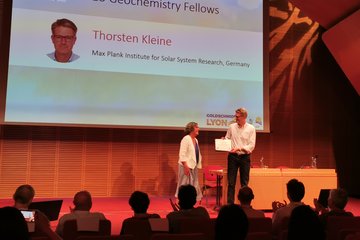Alle Typen
421.
Vortrag
Response of the Martian upper atmosphere to lower atmospheric dust storms: GCM study. Fifth international workshop on the Mars Atmosphere: Modelling and observations, Oxford, UK (2014)
422.
Vortrag
Dynamical coupling between the lower Martian atmosphere and thermosphere. 40th COSPAR Scientific Assembly, Moscow, Russia (2014)
423.
Vortrag
Influence of global dust storms on the mesosphere and lower thermosphere of Mars. European Planetary Science Congress 2014, Cascais, Portugal (2014)
424.
Vortrag
Determination of an upper limit for the water outgassing rate of the main-belt comet P/2012 T1 (PanSTARRS). Asteroids, Comets, Meteors, Helsinki, Finland (2014)
425.
Vortrag
Models for Temperature and Composition in Uranus from Spitzer, Herschel and Ground-Based Infrared through Millimeter Observations. American Astronomical Society, DPS meeting #46, Tucson, AZ, USA (2014)
426.
Vortrag
Models for Temperature and Composition in Uranus from Spitzer, Herschel and Ground-Based Infrared through Millimeter Observations. EGU General Assembly, Vienna, Austria (2014)
427.
Vortrag
Jupiter Icy Moons Explorer (JUICE): Science Objectives, Mission and Instruments. 45th Lunar and Planetary Science Conference, The Woodlands, Texas, USA (2014)
428.
Vortrag
Tracing the gas composition of Titan's atmosphere with Herschel: Highlights. 40th COSPAR Scientific Assembly, Moscow, Russia (2014)
429.
Vortrag
Tracing the gas composition of Titan's atmosphere with Herschel: Advances and Discoveries. 46th Annual Meeting of the Division for Planetary Sciences, Tucson, AZ, USA (2014)
430.
Vortrag
The HCN distribution in the stratosphere of Titan: an intercomparison between the HCN distributions obtained with Herschel/PACS and APEX-2. Asia Oceania Geosciences Society (AOGS) 11th Annual Meeting, Sapporo, Japan (2014)
431.
Vortrag
Inversion simulations for the MIRO instrument on board of the Rosetta orbiter: characterizing the information content. 11th Annual Meeting, Asia Oceania Geosciences Society, Sapporo, Japan (2014)
432.
Vortrag
Submillimeter Observations of Chlorine-bearing Molecules in Venus Middle Atmosphere. Asia Oceania Geosciences Society (AOGS) 11th Annual Meeting, Sapporo, Japan (2014)
433.
Vortrag
General circulation modeling of the Jovian stratosphere. European Planetary Science Congress 2014, Cascais, Portugal (2014)
434.
Vortrag
JUICE, a European mission to the Jovian system. 40th COSPAR Scientific Assembly, Moscow, Russia (2014)
435.
Vortrag
JUICE: The ESA Mission to Study Habitability of the Jovian Icy Moons. Workshop on the Habitability of Icy Worlds, Pasadena, USA (2014)
436.
Vortrag
Revealing the water cycle on Mars via D/H isotopic measurements. American Astronomical Society, DPS meeting #46, Tucson, AZ, USA (2014)
437.
Konferenzbericht
Development of MMIC Schottky Diode Mixers For Space-Qualified Applications In The Tera-Hertz Range. In: 2019 IEEE MTT-S International Microwave and RF Conference, IMARC 2019, S. 1 - 3. (2020)
438.
Poster
Tracing HCN on Titan´s atmosphere with Herschel and submillimetre ground-based telescopes. EPSC-DPS Joint Meeting 2019, Geneva, Switzerland (2019)
439.
Poster
New high-precision triple oxygen isotope measurements of lunar rocks. Goldschmidt Conference 2019, Barcelona, Spain (2019)
440.
Poster
Digitally tunable 150 GHz Local Oscillator chain for the Submillimeter Wave Instrument onboard the ESA JUICE mission. 30th International Symposium on Space Terahertz Technology, Gothenburg, Sweden (2019)











